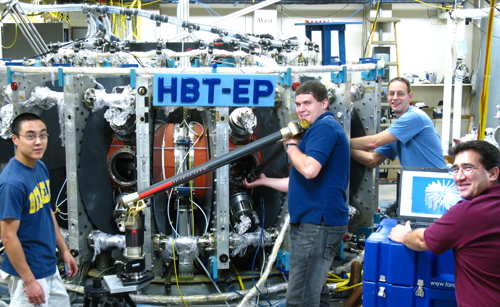APAM Students Conduct Novel Experiment
Aug 19 2010
 |
| Columbia Engineering graduate students Daisuke Shiraki, far left, and Jeff Levesque, second from right, with Penn State engineering intern Jonnathan Cummings, middle, and Princeton Metrology expert, Steve Raftopoulos, acquire detailed position measurements of the newly installed tokamak sensors and controllers. |
Columbia Engineering students and scientists conducting the largest applied physics experiment on campus are taking their final steps, as they reassemble the world's most highly instrumented tokamak used to study advanced control methods for fusion energy.
Graduate student Jeff Levesque has been working with Adjunct Assistant Professor Dave Maurer and Professor Mike Mauel, both in the Department of Applied Physics and Applied Mathematics, along with metrology experts from the Princeton Plasma Physics Laboratory, to precisely measure the locations of more than 250 sensors and 120 control loops throughout the two-meter diameter of the HBT-EP tokamak. A tokamak is a magnetic confinement device that is the world’s most-studied candidate for producing controlled thermonuclear fusion power.
Over the summer, Columbia Engineering undergraduate and graduate students wound, assembled, wired, installed, calibrated and tested the more than 400 coils that surround the plasma inside the tokamak. The final assembly step is underway now, as they make precise measurements on where all of the coils are located. In September, the tokamak will be used to heat hydrogen gas to more than one million degrees and confine the high-temperature ionized gas with strong electromagnets. The tokamak itself will be an experiment to see if, as Mauel explains, “our 400 newly installed and precisely aligned coils can be used to control the fine structure of the edge of the million-degree plasma.”
The tokamak, located on the first floor of the Mudd building, is used to develop, test and understand methods to control instabilities that may disrupt the operation of future fusion power plants. Mauel and his colleagues, including Maurer and Professor Gerald Navratil, have pioneered active control techniques that will be used in upcoming experiments in the ITER device (the international fusion experiment, being built in France) that will produce fusion energy at the scale of a power plant.
“This summer has been a terrific opportunity for our students,” says Mauel. “They have gained unmatched hands-on experience, learned a lot about interdisciplinary engineering, and developed strong applied science skills.”
